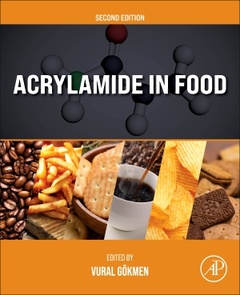Description
Acrylamide in Food (2nd Ed.)
Coordinators: Gokmen Vural, Mogol Burce Atac
Language: English
Subjects for Acrylamide in Food:
644 p. · 19x23.4 cm · Paperback
Description
/li>Contents
/li>Biography
/li>Comment
/li>
Acrylamide in Food, Second Edition, is fully updated with four new chapters that incorporate current literature on acrylamide, including analysis, formation mechanisms, levels in foods, reduction strategies, and new regulations, such as the one made by the European Union in 2017 regarding the presence of acrylamide in processed foods.
The book comprises of four parts: part one introduces acrylamide and the food chain in the context of harm and health. Part two focusses on acrylamide in various types of foods, such as bakery products, fried potato products, coffee, battered products, water, table olives, etc. Part three highlights its interaction mechanisms and health effects. Part four discusses methods of analysis.
Acrylamide in Food, Second Edition is edited by a team of international experts in the field and is a quality reference in the developing field of acrylamide in food. It is valuable to researchers in the food industry or working on evaluating the factors affecting the formation of acrylamide in different heat-treated foods and the possibilities of reducing acrylamide formation accordingly.
Introduction: Potential Safety Risks Associated with Thermal Processing of Foods 1. Acrylamide Formation Mechanisms 2. Challenges in Estimating Dietary Acrylamide Intake 3. Trends in Food Acrylamide
Section A. Acrylamide, The Food Chain in the Context of Harm 4. Acrylamide Intake, Its Effects on Tissues and Cancer 5. Maternal Acrylamide and Effects on Offspring 6. Metabolism of Acrylamide in Humans and Biomarkers of Exposure to Acrylamide
Section B. Acrylamide in Foods 7. Mitigation Measures and Benchmark Levels for Acrylamide in Foods 8. Acrylamide in Bakery Products 9. Acrylamide in Fried Potato Products 10. Acrylamide in Coffee and Coffee Substitutes 11. Acrylamide in Soybean Products, Roasted Nuts and Seeds, and Dried Fruits 12. Acrylamide in Tea Products, Prof. Fang Chen, College of Food Science and Nutritional Engineering 13. Acrylamide in Table Olives 14. Acrylamide in Battered Products 15. Acrylamide in Surface and Drinking Water
Section C. Interactions and Reductions 16. Role of Hydroxymethylfurfural on Acrylamide Formation during Thermal Processing of Foods 17. Multiresponse Kinetic Modelling of Acrylamide Formation in Foods 18. Reactions of Acrylamide during Digestions of Thermally Processed Foods 19. Use of Nucleophilic Compounds, and Their Combination, for Acrylamide 20. Lipid Oxidation Promotes Acrylamide Formation in Fat-Rich Systems. 21. Relationship between Antioxidants and Acrylamide Formation 22. Interaction between Bioactive Carbonyl Compounds and Asparagine and Impact on Acrylamide 23. Effect of Inorganic Salts on Acrylamide Formation in Cereal Matrices 24. Inhibition of Acrylamide Formation by Vanadium Salt in French Fries and Potato Chips 25. Impact of L-Asparaginase on Acrylamide Content in Fried Potato and Bakery Products 26. Alternative Technologies for the Mitigation of Acrylamide in Processed Foods
Section D. Methods of Analysis 27. Colour Image Analysis for Detection of Acrylamide 28. Rapid Spectroscopic Methods for Quantitation of Acrylamide in Foods 29. Analysis of Acrylamide in Foods with Special Emphasis on Sample Preparation and Gas Chromatography–Mass Spectrometry Detection 30. Liquid Chromatographic Tandem Mass Spectrometry to Determine Acrylamide in Foods 31. Quantitation of Acrylamide in Foods by High-Resolution Mass Spectrometry 32. Detection of Acrylamide by Biosensors
Professor Gökmen graduated in 1990 with food engineering degree, and gained his PhD degree in 1998. In 2004, he was awarded as outstanding young scientist by the Turkish Academy of Sciences, and in 2007 he received the science incentive award by Scientific and Technological Council of Turkey. In his career Professor Gökmen has carried out national and international research projects related to different aspects of food science. He has collaborated with research groups in Italy, Spain, Germany, France, Netherland, USA, UK, Czech Republic, Slovakia, Serbia, Belgium, and Denmark. Professor Gökmen has founded Food Research Center at Hacettepe University in 2010, and he served as founding director until Feb 2013.
Dr. Ataç Mogol is an experienced researcher with a strong background in food science. She has over 15 years of experience in processing contaminants, including their formation, mitigation, and presence in foods.
She has her Ph.D. degree in food engineering from Hacettepe University in 2014, and she published 36 peer-reviewed articles, 4 book chapters, and 1 patent that reflect her research interest in processing contaminants, including acrylamide. Dr. Ataç Mogol has been involved in many national and international research projects and she is currently on the editorial board of the F
- Thoroughly updated revision, providing detailed information on acrylamide formation in various foods
- Includes updated content on new regulation regarding the presence of acrylamide in processed foods
- Includes interaction of acrylamide with other compounds and its fate during digestion
- Explores acrylamide in the food chain in the context of harm, such as acrylamide and cancer, neuropathology of acrylamide, and maternal acrylamide




